Did you know that in 2020 Facebook Messenger will turn 9? It was launched on August 9, 2011, a few months after Facebook Pages began rolling out for businesses.
Facebook has been developing both tools over the past decade, and they’ve recently made some major updates to the Messenger app so that businesses can better serve and connect with potential customers.
Connecting with leads, followers, and customers is a major priority on social media for all brands. There’s an enormous focus on driving engagement, getting attention, and generating conversations.
By that standard, connecting with users individually on direct chat platforms like Facebook Messenger is about as good as it gets.
In this post, we’re going to take a close look at how businesses can use Facebook messenger to connect with their audiences at all stages of the digital sales funnel.
Let’s get started.
What Is Facebook Messenger & Why Does It Matter?
Facebook added private chat functionality to the platform in April 2008, and named it “Facebook Chat”. The success among users was satisfying, but not good enough to meet Zuckerberg’s plan of creating “the best tool to increase connectivity around the world”.
Three years later, in August 2011, Facebook Chat was removed from the mobile Facebook app and placed instead in the standalone-but-still-integrated app that has since become Facebook Messenger. And it has since boomed in a big way.
Facebook Messenger now has about 1.3 billion people using the app every single month, and more than 20 billion messages are exchanged between users and businesses on the platform each month.
An increasing number of customers are turning to private and live-chat options on social media like Messenger to address questions or concerns, whether they had their interest piqued by an ad or they had a negative customer experience that needs to be addressed.
In 2020 Facebook Messenger is also sophisticated, going beyond basic chat options. There is everything from auto-responses to chatbots to automated booking features that businesses can use to streamline conversations with customers and accomplish their goals.
This means that it’s crucial for brands to be prioritizing responses and engagement on Facebook Messenger, and that they should be treating Messenger as a core part of their overall social strategy.
Because if you’re not, you can count on the fact that your competition will.
How Brands Can Use Facebook Messenger to Their Advantage
There are a number of different ways that you can leverage Messenger to help you accomplish your specific goals.
Here are a few key use cases to keep in mind:
- Respond to customer questions and comments promptly and one-on-one
- Set up chatbots to help customers track orders, discover new products or content, and even make purchases
- Use native tools to make Messenger exchanges more valuable for your audience
- Create “Messenger Ads” that are designed to drive conversation by getting people in touch with your brand through Messenger
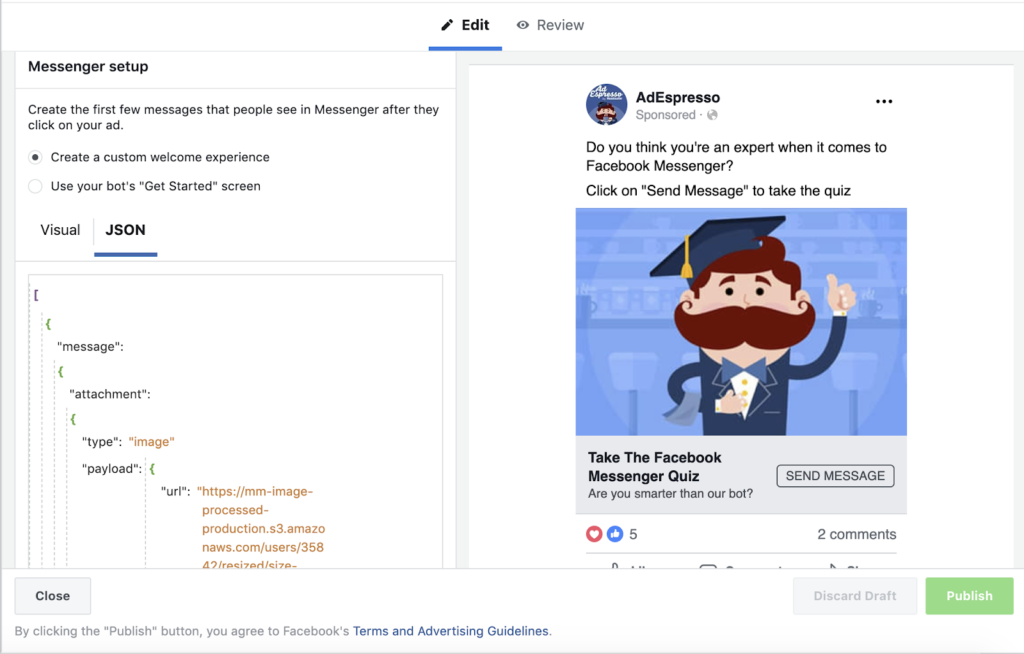
The Messenger ad we used for our $1,000 Experiment Facebook Messenger Ads and Chatbots: Do They Really Work? Click to read it!
Business Rules for Facebook Messenger
Before we start looking at exactly how to use Messenger for your business, it’s important to go over a few key ground rules laid out by Facebook about how to use the platform.
These are the big ones you need to know about, and they’re all brand new and updated.
-
Standard Messaging
Pages have up to 24 hours to respond to a user, and messages sent within the 24-hour window may contain promotional content. Since users expect businesses to respond past, this is important.
And after March 4th, 2020, you won’t be able to send one additional message after the 24 hours is over like you are now, so take note of that.
-
Message Tags
Businesses can send 1:1 updates to users who have opted into them. This can happen outside of the 24-hour standard messaging rules, and it can only be for important and “personally relevant updates.”
This can include sending them automated updates on their order status once a package has shipped.
-
Subscription messaging
Only Pages that are registered with the Facebook News Page Index (NPI) can send non-promotional subscription messages.
-
Sponsored messages
Businesses are able to send promotional content outside the 24-hour standard messaging window, but they need to pay up to do so with Sponsored messages. These are part of the Facebook Ad system.
-
Chatbots need to respond within 30 seconds
Pretty self-explanatory, but if you’re using a chatbot on the platform, you’ll want to make sure that it’s in great shape to be responsive.
These are the basics. To make it even more clear:
- You really need customers to reach out to you before you can contact them (unless you want to reach them with Sponsored Message ads).
- When customers do reach out, you need to respond fast.
How to Set Up Facebook Messenger for Your Business in 5 Steps
Let’s take a quick look at how exactly you should set up Messenger for success for your business. You can do all of this from your Page’s “Settings” tab.
Step #1 – Enable Messaging for Your Page
From your Page’s “Settings,” find the “General” tab, and then scroll down until you see “Messages.”
Click “Edit,” and ensure that you have messaging functionality turned on. If you don’t, people won’t be able to reach out to you through Messenger, and everything else you do will be for naught.
Step # 2 – Set Up Instant Greetings
You want to drive as many people to Messenger as possible so that you can have a direct conversation with them, addressing whatever needs or questions they have a one-on-one. Instant Greetings are a great way to do that.
This is a native feature on Facebook that allows you to have a Messenger box for your brand open up as soon as a user navigates to your Page.
This can have a message encouraging users to shoot your questions or be blank, but it does give people a quick reminder that they can (and should!) get in touch!
To enable this helpful feature, go to the “Messaging” section in the Settings window, and then find “Starting a Messenger Conversation.”
Turn on the “Show a greeting” option, and customize the greeting as you see fit, incorporating branded language.
Step # 3 – Set Up Automated Responses
These instant-replies are a key part of the new-and-improved Messenger that businesses love.
Automated responses will save you and your inquiring customers a ton of time by providing them with pre-loaded, automatic responses to specific questions.
You can automatically send users a response letting them know that you’re currently away but will respond as soon as you’re back, or provide instant contact information options for anyone who needs them.
You want to take advantage of these automated responses. They give customers the information they need fast and save your team some time managing the messages, too.
In order to enable them, head to “Settings” and then find “Messaging” again. Scroll down and you’ll see “Automated Responses.”
Once you click, you’ll be able to see a large number of different automated responses that you can customize and enable, which include the option to add CTA buttons like “visit website” or “book appointment.”
Step # 4 – Consider Whether a Chatbot is Right for You
Facebook Messenger has plenty of chatbots that use a series of menus and responses to text clues to help you make purchases, track orders, and more. You can even reorder one of your favorite items from Dominoes instantly all from a chatbot on Messenger.
Chatbots aren’t right for everyone, especially since we have so many incredible automated responses available to us now.
If you think you could benefit from one, great! If not, that’s ok, too. You can learn more about them here.
Step #5 – Consider Using a Third-Party Service for Message Management
While chatbots may not be for everyone, third-party social management software absolutely is.
You need to respond to all incoming messages within 24 hours. That sounds easy, but in reality, it’s just not.
Life is so busy, and you’re not just keeping up with one customer on a single platform; you’ll have an ever-growing list of customers messaging you on Facebook, Instagram, Twitter, LinkedIn, and more.
Social media management software like Hootsuite is a lifesaver here.
You’ll be notified of all incoming direct messages so that you can respond promptly, and even assign individual messages to specific team members so nothing gets missed.
These platforms come in a variety of different price points, making them accessible for businesses of all sizes.
Facebook Messenger Best Practices
Want to get the most out of Messenger? Consider following these best practices.
Respond Quickly
You have to respond within 24 hours, but ideally, you’ll respond even sooner than that when someone shoots you a message through Facebook.
The average consumer has higher expectations than ever before, with many wanting near-instantaneous service (I blame Amazon’s same-day delivery, frankly).
Not only will you be able to help people quickly, you’ll also be flagged as a business that responds fast on your public Page. You can see this in the example below, where Snappa mentioned to “typically reply within a day.”
The faster your brand responds on average, the better, and customers will take note of this.
Offer Personalized Service to Each Customer
There’s something to be said for automated responses on Facebook Messenger. They’re useful, but they aren’t all-encompassing, so these instant replies should be used to improve your customer support on Messenger, not be the entire support.
Plenty of customers will turn to Facebook when they need actual personalized help from a real person, so having customer service representatives working with customers on this platform is a great choice.
I recently couldn’t get ahead of Verizon when I called, for example, about someone potentially hacking my account, but I was able to reach someone on Messenger, ironically enough. They walked me through the steps I needed to take, and they weren’t relying on chatbots to do basic (and ultimately unhelpful) troubleshooting.
Frequently Encourage Users to Message You Privately
You’ll commonly see brands encouraging customers to message them privately.
They may do this when a user wins a Facebook contest, for example, and the brand needs their contact information. It’s also common with someone expresses a complaint or concern, and the brand encourages the individual to message them privately so they can offer more personalized attention.
Make this a common practice.
If someone is unhappy, wants to talk more, or seems concerned about something, encourage them to shoot you a message for more details. This is a great way to start productive conversations with your audience members.
Use Sponsored Messages to Re-Engage Lost Audience Members
Sponsored Message Ads are private messages sent to individual users inboxes, and they show up similar to regular messages.
You can only send them to users who have engaged with you in the past 30 days, but they’re incredibly valuable; users get a notification that you messaged them, and they need to view it to clear it.
You can add in CTAs, coupon codes, and traditional message text to showcase your offer and capture users’ attention. This is a great way to re-engage and retarget customers who dropped off and didn’t purchase, increasing the likelihood that they do so moving forward.
For best results here, consider including discounts and incentives to sweeten the deal.
Final Thoughts
Most businesses don’t really consider Facebook Messenger as a priority, but that shouldn’t be the case at all.
Messenger is where customers will most likely reach out with questions that need answering, including those that may be preventing them from purchasing until they receive an answer.
Fast, attentive customer service and engagement here can make a huge impact on those messaging you, which in turn can have a very big and very positive impact on your brand, too.
Keep in mind, too, that sometime this year, we’re expected to see an enormous integration between Facebook Messenger, WhatsApp, and Instagram Direct messaging.
These companies are all owned by Facebook, and in early 2019 it was announced that they were working on creating an integration with the three apps so that Pages could see messages from all three in the same place.
More emphasis than ever before may be placed on Messenger, so the time to start testing out new strategies is now.
What do you think? How do you use Facebook Messenger to reach your target audience? Which strategies have worked best for you? Share your thoughts and questions in the comments section below– we can’t wait to read them!
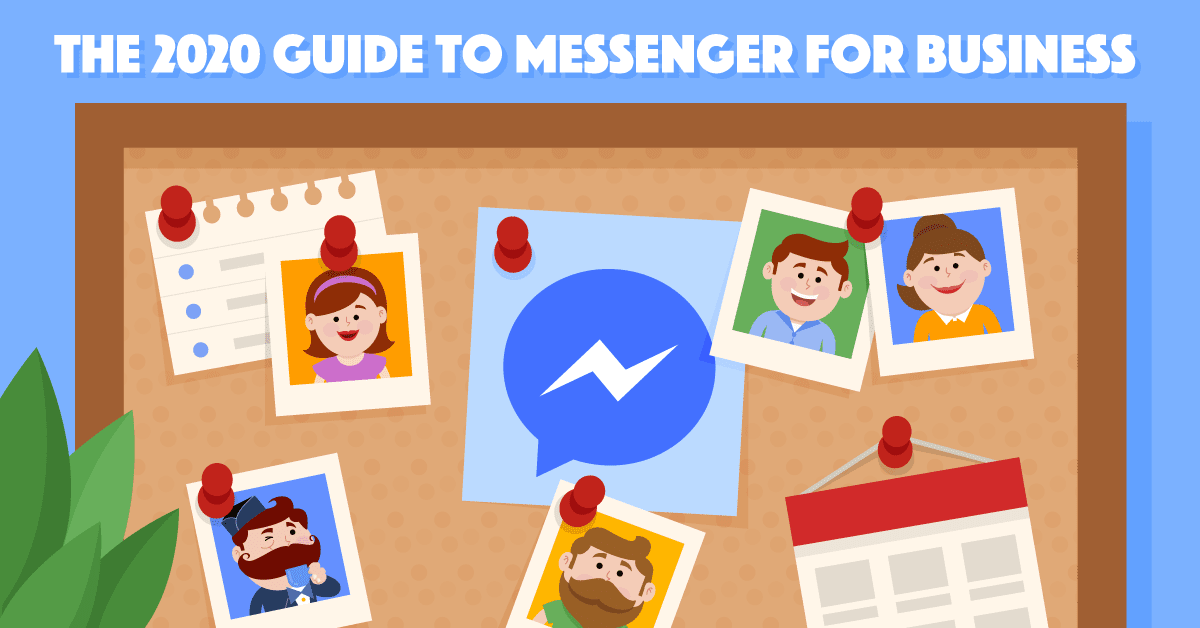
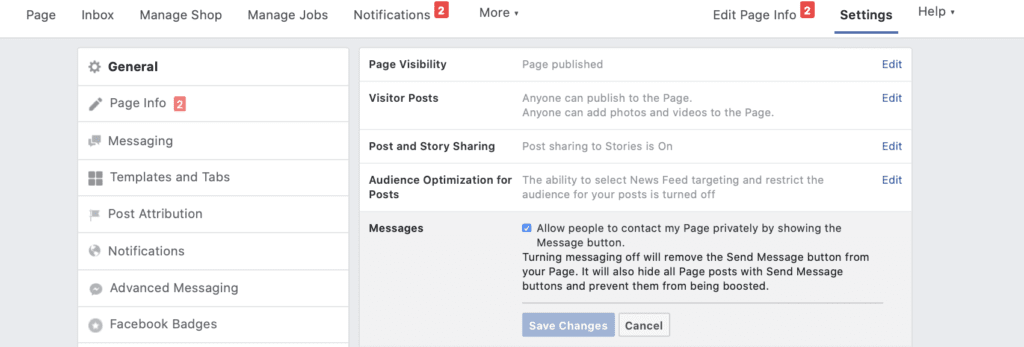
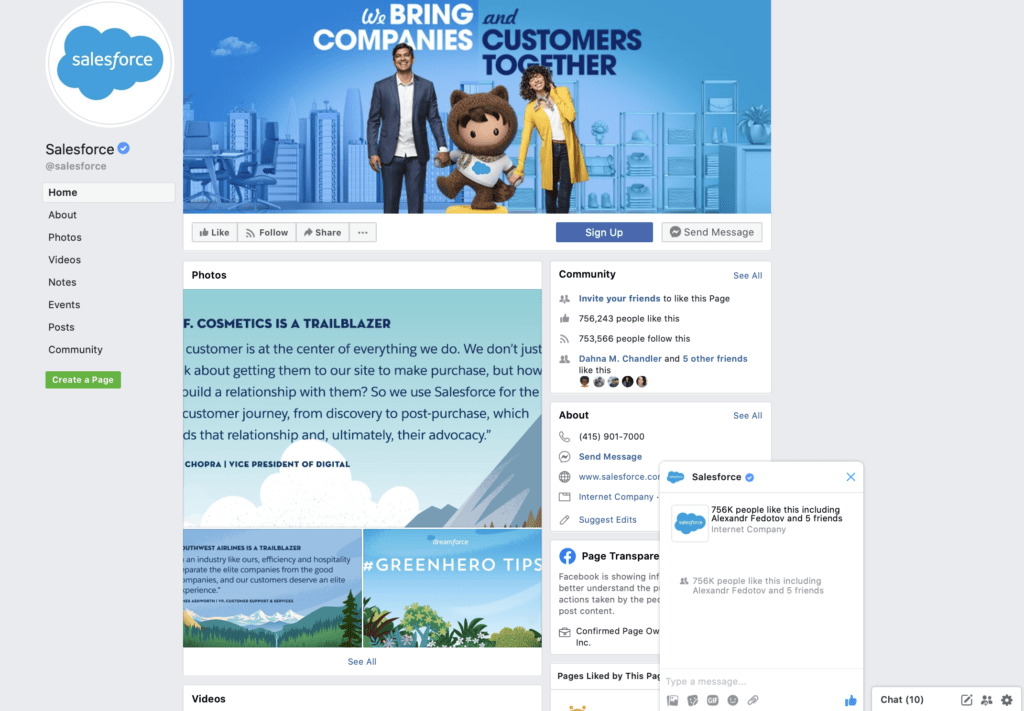
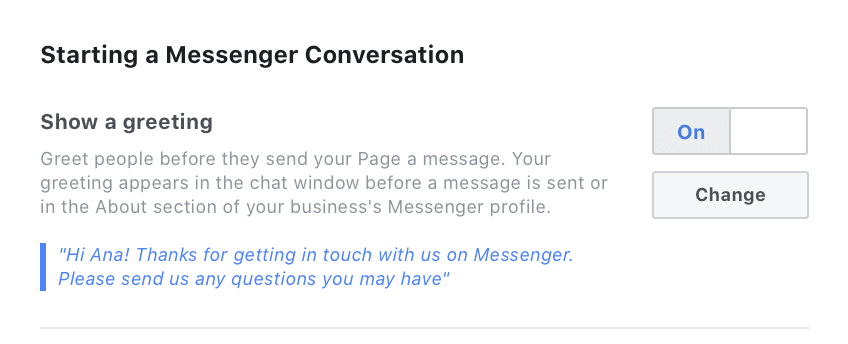
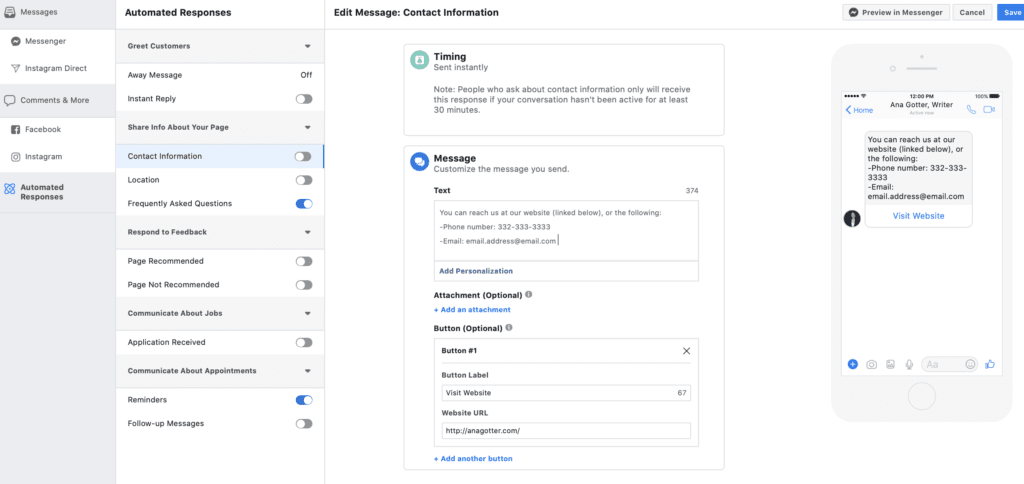


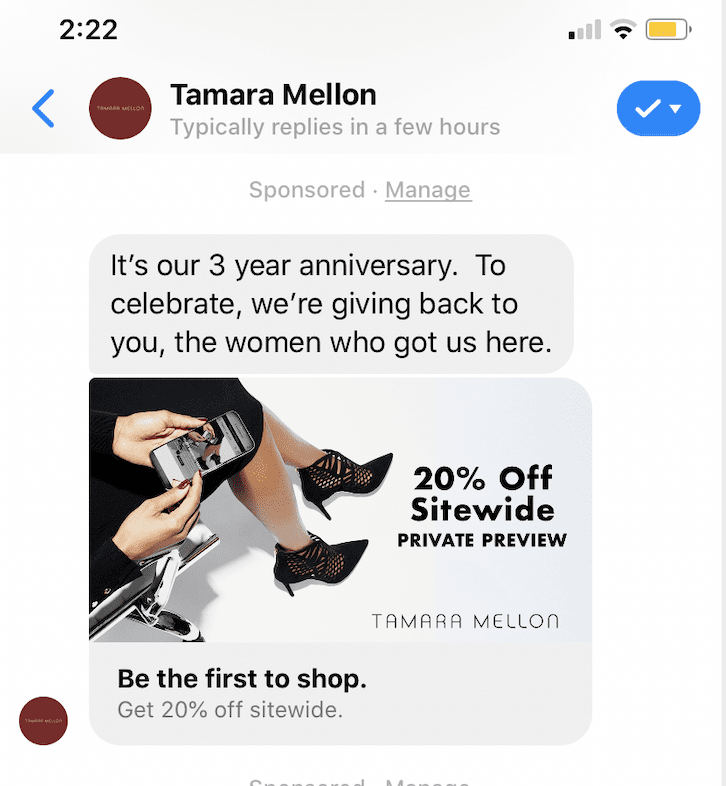
Leave a Reply